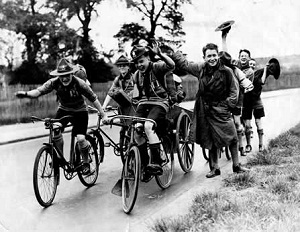
A Bike Trip Towards Happiness
 Good cycling habits in countries seems to have a relation with better ranks in the UN World Happiness Report. Photo by John Mueller - Flickr.
Good cycling habits in countries seems to have a relation with better ranks in the UN World Happiness Report. Photo by John Mueller - Flickr.
The “World Happiness Report” is a study by the United Nations’ Sustainable Development Solutions Network, aiming to determine the levels of perceived happiness in the countries according to a set of criteria ranging from average income to mental wellness to freedom of movement and action.
The report, whose second edition has recently been released, is a traditional headline-maker.
John F. Helliwell, Richard Layard and Jeffrey D. Sachs, editors of this massive study, are convinced that measurements of well-being can be used effectively to assess the progress of nations and tailor policies accordingly.
At the ECF, we also have opinions on how certain policies (namely: pro-cycling measures) can improve the people’s well being, thus their productivity and the economy as a whole.
Therefore it came as little surprise to us discovering that the world’s happiest countries rank at the very first places also in the ECF Cycling Barometer. In other words: the more a country rides, the happier it is.
Limiting the analysis to EU countries (as the Cycling Barometer includes EU27 countries only), here are the top seven cycling nation (in brackets their World Happiness Report ranking):
1. Denmark (1)
2. The Netherlands (2)
3. Sweden (3)
4. Finland (4)
5. Germany (11)
6. Belgium (8)
7. Austria (4)
And these are the EU27 countries ranking at the seven lower places of the Cycling Barometer:
21. Lithuania (21)
22. Cyprus (12)
23. Portugal (23)
24. Spain (13)
25. Bulgaria (27)
26. Romania (25)
27. Malta (18)
The correlation between the countries’ scores in the two classifications doesn't seem to be a series of coincidences. Let’s try to investigate in brief the conceptual relationships between some of the criteria the UN has used to assess the countries well-being and how having more people cycling more often can have a great impact on a country's happiness.
We are not claiming any scientific evidence: our aim is merely to spur further analysis on how an increased propensity to cycle could lead to an improvement of one's quality of life.
Quick parameters overview: to obtain their happiness indexes, Helliwell, Layard and Sachs use a series of factors: healthy life expectancy, perceptions of corruption, GDP per capita, freedom to make life choices, social support, generosity.
 Physical inactivity is estimated to deprive Europeans of over 8 million days of healthy life every year. Photo by gothormr / Flickr.
Physical inactivity is estimated to deprive Europeans of over 8 million days of healthy life every year. Photo by gothormr / Flickr.
HEALTHY LIFE EXPECTANCY – According to the World Health Organization, two thirds of the adult population in the EU does not reach the recommended levels of activity. As a result, physical inactivity is estimated to deprive Europeans of over 8 million healthy days of life every year, on average. In the US, according to the American Heart Foundation, 32% of adults do not engage in any leisure-time physical activity, and between 34% and 68.4% (depending on education level) of Americans fail to achieve the recommended amount of exercise. Unhealthy lifestyles affect happiness. Encouraging people to bike to work, school, errands and for recreation can mean a lot in terms of fitness, health and eventually happiness.
SOCIAL SUPPORT - Helliwell, Layard and Sachs define it as “having someone to count on in times of trouble”. Less motorized traffic means a more liveable environment, and this improves the quantity and quality of human relations, which are the most valuable assets in times of crisis. A 1995 study of social contact in San Francisco schools showed that, on average, kids living on streets with light traffic had three times as many friends and twice as many acquaintances as those living on streets with heavy traffic. A 2006 study by Transportation Alternatives in New York came to the same conclusions.
MENTAL ILLNESS – According to Helliwell, Layard and Sachs, mental illness is the single most important cause of unhappiness. Around 10% of the world population suffers from some form of psychological disorder. Depression hits 404 million people around the planet, and 272 million people suffer from anxiety. Among the factors that cause mental illnesses, there is the lack of those values that sit at the very heart of the human condition, and among these Helliwell, Layard and Sachs number social interaction and independent action. Cycling can do something here, not to mention the power it has to stimulate the release of happiness-hormones.
 Social interaction is one of the keys to happiness. Leisure-rides allow groups of like-minded people to get together. Photo by fixedgear / Flickr.
Social interaction is one of the keys to happiness. Leisure-rides allow groups of like-minded people to get together. Photo by fixedgear / Flickr.
SOCIAL INTERACTION – There would probably be more social interaction if people rode more often. Car drivers sit alone in their own environment. Public transport users have lower independence. Cyclists may enjoy higher levels of interaction. Leisure-rides allow groups of like-minded people to get together; and the absence of parking or bus timetable hassles allows more socializing time; local shopping is preferred, and all this implies intensified contact with people. Since they often have to stand up for their rights, they are likely to come together in associations, lobbies, demonstrations.
INDEPENDENT ACTION – The infinite frustration of a traffic congestion; that sense of loss on car-free days; the impoverishment caused by increasing oil costs; the impossibility to access by car some areas of our city. We all know the complete sense of impotence related to such situations, and its effect on our mood. Don’t we? Cyclists don’t. Cyclists can ride almost anywhere, almost at anytime, being the master of their own time and space.
CHEMICAL EFFECT OF EXERCISE ON MOOD AND WELL BEING – Talking about mental sanity, we shouldn’t forget to take into account that when we work out (and regular cyclists include exercise in their daily routine) we produce endorphins, which are a great mood enhancer. There’s plenty of scientific research (a simple Google search will result in dozens of medical and psychiatric articles with such findings) on how physical activity can fight the emergence of depression, thanks to the release of serotonin and endorphins. Again, policies encouraging cycling could positively affect the aggregate feel of communities, thus generating savings in public health expenditure.
HEALTH IS WEALTH – Average household income is one of the criteria Helliwell, Layard and Sachs use to assess the wealth of nations. Here we will not mention the savings that consistent cyclists make on petrol, parking fees, fines, insurance, or on public transport tickets and passes. We prefer to look at a less obvious relation: according to a research by the Ohio State University's Center for Human Resource Research, people who lose weight are more likely to increase their income. A one unit increase in a young person's Body Mass Index is associated with an 8 percent reduction in wealth, while one unit decrease mean 234 extra US dollars at the end of the year. Regular cycling can be part of a weight control strategy, with the financial benefits it, apparently, implies.
GENEROSITY AND EQUITY – It’s indisputable that cycling and equity grow together. Cycling is an instrument to social justice. Bikes serve to decrease transportation disparity, providing low-income individuals with affordable and low-maintenance means of personal transport. Links between inequality and happiness have been widely examined by psychologists, and today the idea that countries with less difference between social classes (think of Scandinavia and its tax and welfare systems, for instance) have higher levels of contentment in their populace is universally accepted. This can placate the conflict between classes and the continued convergence in the quality of the social fabric within greater Europe is, according to Helliwell, Layard and Sachs, one of the causes leading to the increase of happiness and generosity on a global scale which is one of the outputs of the study.
About the author
Alessio Punzi is a Communications Assistant at the European Cyclists’ Federation. He has a Master’s Degree in Sports Management and has previously worked in Rome for a sports events firm. His interests focus on the health benefits of cycling, the related savings for health services and the corresponding EU policies.
- Log in to post comments
Contact the author
Recent news!
Upcoming events
Contact Us
Avenue des Arts, 7-8
Postal address: Rue de la Charité, 22
1210 Brussels, Belgium











